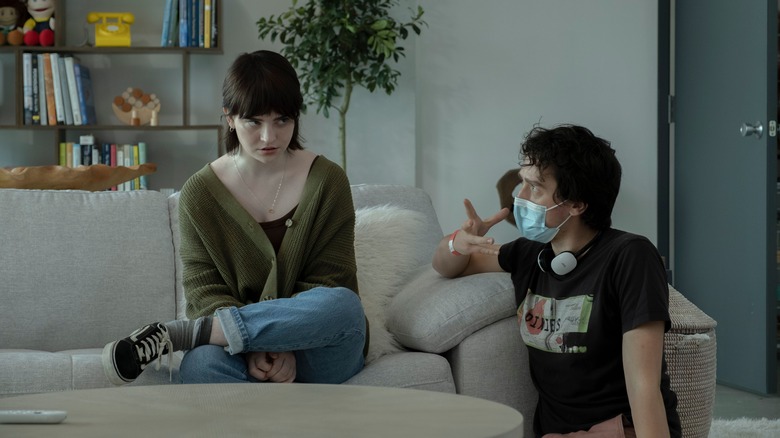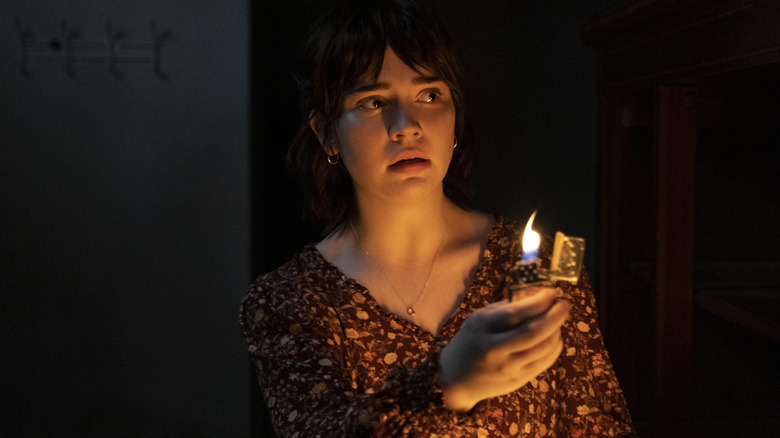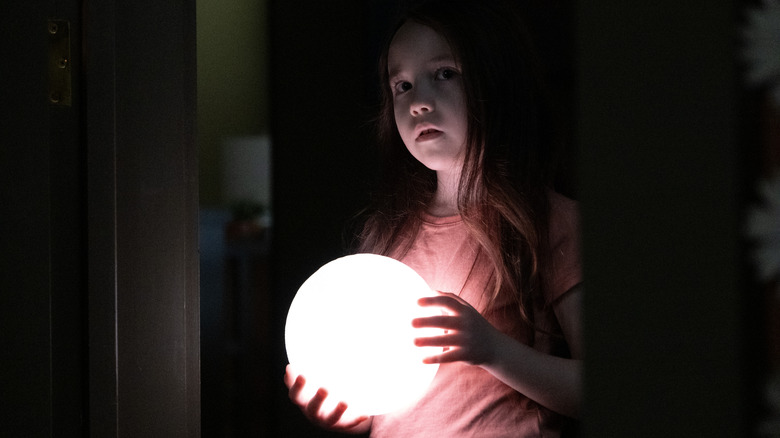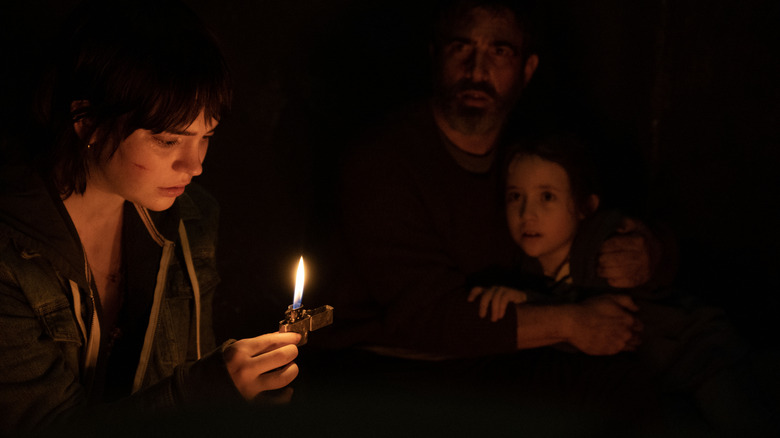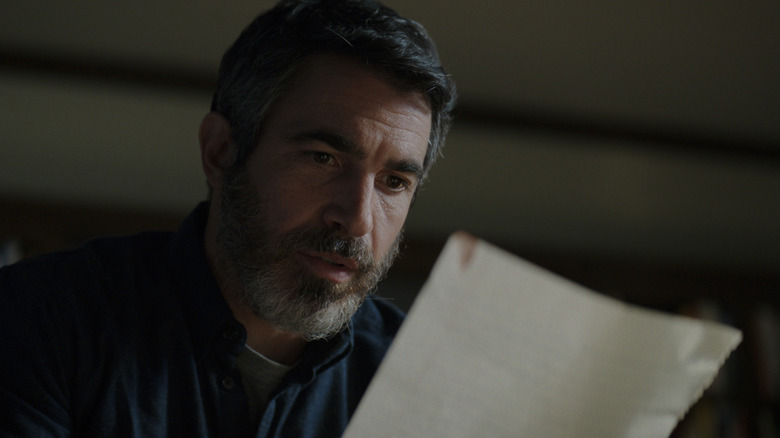The Boogeyman Director Rob Savage On The Film's Scariest Moment, That Ending, And More [Exclusive Interview]
This post contains spoilers for "The Boogeyman."
After directing several short films and a 2012 feature called "Strings," Rob Savage directed television in the UK for years before breaking out in a big way with 2020's "Host," a quarantine movie about a Zoom call séance that went horribly wrong. He followed that up with the disappointing "Dashcam" a year later, but now he's back on track with "The Boogeyman," an effective horror flick that proves he can work in the big leagues.
I spoke with Savage about that transition from low-budget features into his first studio movie, as well as the film's biggest scare, staying one step ahead of audiences, a last-minute change that resulted in what he calls the movie's "best scenes," and much more.
Note: This interview has been lightly edited for clarity and brevity.
'I think it's the only shot in the movie that we did in one take'
I have to ask you about the scene with the recorder flying into the water. Can you tell me about your approach to that and how you ended up pulling that off?
Yeah. Well, we had two of the most intense scenes of the movie kind of intercutting, building, building, building. We just needed something to puncture that dread, a little laugh in order to jump us over to the next scene. We came up with this idea of her flinging it into the water jug, and then we had to figure out how to do it and we ended up just doing it as a simple split screen. Sophie reacts and throws the thing off screen, and then we got our second AD to come in and throw it like he was making a basketball shot, and he got it in one take, amazingly. I think it's the only shot in the movie that we did in one take.
That's incredible. For me personally, the biggest scare in the film is the moment where Sadie slams the door and then the creature comes bursting through it a second later. Can you tell me what went into achieving that? It's so unexpected and intense.
I wanted to make it so that this is a film for everyone, but it's also a film for horror fans, and I wanted to make sure that anytime a horror fan might be getting ahead of me about where the scares are coming from, we had some way of blindsiding them. I wanted it to feel like even in the drama scenes, the daytime scenes, they weren't free to check their phones or make a cup of tea — that something might be coming to get them.
We had this idea of — and it wasn't necessarily inspired by this, but it serves the same purpose as that amazing scare in "Smile" with the head in the car window. We wanted to have just this one moment where her kind of delirious exhaustion led to us having our one and only dream sequence. We had the shot set up where Sophie comes in, she's on a wire rig, so she comes in, she says her line, "Leave me alone, Sawyer," yank, gets pulled back out of shot. We leave the camera locked off, we then clear the set and we attached a pulley onto the door. It was very "Flintstones." We had a pulley on the door with a big rock or something, some big weight, and we dropped the weight and the weight then pulled the door and the door just exploded out, and then we added a boogeyman into the midst of that.
I'm really interested in that idea you just explained about trying to stay one step ahead of the horror fans. Are there any other moments that you can think of where that was the driving force behind including a certain moment?
Well, the opening of the movie I wanted ... the opening of the movie is quite intense and quite hard, and I wanted to set out from the very beginning that this was a movie where nobody was safe, including and especially children, this being the boogeyman. There was a lot of back and forth — this is a PG-13 movie and we had to make sure we got that certificate, and there was a lot of back and forth on whether that was going to be able to stay in the movie as is. For some reason, I guess they must have been looking at their phones at the time, but the MPA had no problem with that opening scene and it stayed in the movie. These things are kind of codified and there are certain rules: You don't kill kids, you don't kill dogs. There are things horror fans know are kind of baked into the dogma of horror movie making, and it was important they felt like this movie was a little bit more deranged than their usual PG-13 horror movie.
'That's one of the most iconic shots of our movie, and it was a complete accident'
I love the way that the characters weaponized light in this movie. Sawyer has her light ball, and then there's that great sequence with the video game character lighting up the screen later on. Can you talk about how you and your cinematographer wanted to visualize scenes like that?
Yeah, I mean, the moon ball is an interesting one because that's our poster image. That's one of the most iconic shots of our movie, and it was a complete accident because we developed the movie — this being a Disney movie, if you can believe it — we developed the movie with Vivian's character having a knockoff lightsaber as her means of illuminating her bedroom. Because I had a toy lightsaber that was rubbish as a kid, a knockoff one, and the idea was that it was going to fritz and it was going to start sending these lighthouse beams of light up the hallway and then back. It was kind of like we were playing with that same idea of what's visible and what's not.
Then of course, I had completely forgotten that we'd cast young Princess Leia and the idea of young Princess Leia holding a faulty lightsaber wasn't one that Disney wanted to go forward with, so we had to madly scramble to come up with something else. Me and the production team just spent a night Googling "kids toys that make light," and we found this moon ball and wrote these couple of scenes within a couple of hours and they ended up being the best scenes in the movie.
Have you ever had that happen before, where a decision from on high sent you into a catastrophic mode of, "Oh my god, we have to come up with a solution to this right now?"
Yeah. I mean, you don't like to say this because it never feels like this at the time, but it almost always makes the thing better, and it almost always makes you boil down the scene to "What's the most fundamentally important part of this?" It's not that it's a lightsaber, it's that we've got something whereby we can play with light and dark in a fun way that can surprise the audience.
I'll be completely honest with you: I thought the creature design was fairly boring for a lot of this movie, but then at the end, you actually get to see a lot of it up close and I ended up doing a complete 180 on it and thinking that it was super interesting once it starts peeling open its own face. What was important to you about the look of the creature?
Well, it's exactly like you say, I wanted it to feel like there was an unknowable quality to this creature. For a large part of the movie, we were just doing the fin above the water in "Jaws." We weren't really showing this creature. It needed to be kind of stark and striking, but mostly it needed to bleed off into the shadows and be something that the audience could use their imagination to fill in the rest. Then when you finally see the creature, the idea was that you're going to see it, so we are going to fulfill the mandate of this being a big Friday night popcorn horror movie. You want to see the monster, you want it to fight our lead character, but also it's going to reveal some Lovecraftian depth to it that's ultimately going to kind of set your mind on fire and think that you've only seen a fraction of what this thing truly is.
It was really our attempt to one, kind of building in this reveal whereby this kind of grinning toothy look that we've seen throughout the rest of the movie is revealed to be knuckles and fingers that then come out and reveal this inner self. Then it was also about, it was an homage to the short story, which ends, of course, with the therapist character peeling off its skin and revealing to be the boogeyman within. It was our way of honoring that.
'It walks the line of being cheesy, and hopefully is just on the right side of it'
At the end of the movie, when the family is watching the house burn, initially my gut reaction was wondering if the underlying message there may have been a little harsh — this idea that all of the memories of their mother are being incinerated in order for the rest of the family to be able to move on and live their lives. But I think that harshness is actually eased up a bit by having the mother's spirit be involved with helping save them. Like the mom is fire, in a way. I'm curious if you had conversations about that at any point in the process.
Yeah, I think we always knew that there was going to be this act of letting go at the end. The basement full of these kind of stagnant memories had to go up in flames, and that was going to be part of it. There was going to be a necessary cleanse that happened, but we couldn't, in the script, really make it work because of the reason that you've said: It felt harsh to say to this grieving family, "No, you can't hold onto any memories."
At the same time, we were kind of developing this idea of the boogeyman is this ultimate force of darkness. It's this eternal demonic thing that we just call the boogeyman, but it's basically this force of darkness and that we should kind of counterbalance with some spiritual force of good. It's one of the hallmarks of a lot of Stephen King, is there is always hope and humanity even in the darkness. It felt of a piece with his work to go that far. It walks the line of being cheesy, and hopefully is just on the right side of it.
The idea is that this family who have each other have also internalized enough of the mum's spirit and that she's still there and they're able to conjure her in this way, and she still exists around them in the same way that the creature still exists around them. The end of the movie is very much saying that any darkness we experience, like depression, it's always there lurking. You just don't lean into it. It's a constant process.
'He's been one of my favorite actors for a long time'
I think Chris Messina has steadily become one of the most reliable actors in the business, and I'm curious what your experience was working with him.
He's incredible. I think he was the first person that we cast. He's been one of my favorite actors for a long time. I think he elevates everything he's in. My friend has a theory that there are certain actors who are 23 percenters: They make movies 23 percent better, no matter what the material is. Chris is, I'd say he's probably more than a 23 percenter, but he's definitely in that camp.
His part is a hard one as well because he's basically, everything's going on internally. He's a character that doesn't want to wear his emotion on his sleeve and really doesn't want to engage emotionally with his children. He spends most of the movie denying their experience. It's a part that in anyone else's hands could be deeply unlikable, but I just think it's impossible to dislike Chris Messina. I think he's got such a warm presence. He's so able to invite the audience in to share the inner world of his character. He also takes lines that you have to have in a monster movie that in another actor's mouth might seem cheesy, and he makes them feel like John Cassavetes. He's able to bring everything down to a place of authenticity that's amazing.
He's wonderful. What was the biggest thing that you learned from stepping up into a studio horror film like this? Is there one particular takeaway that you internalized on this process?
This feels like a cop out, but I think weirdly, the experience of making this didn't feel that much different from making the last two movies, even though I shot them both on an iPhone. And I was dreading it. I thought maybe I wouldn't be fully equipped to make this step up. I've done a bunch of big TV in the UK, but it'd been a long time. There had been a whole pandemic and two iPhone movies in between, and I was a little worried about being in that space again. As soon as you're kind of in that inner sanctum with the actors and the camera and all of the trucks and the hundreds of other people who are standing around, as soon as that bleeds away, it feels like the same thing if you're really doing it right, which is thinking about the audience experience first and foremost. It was just every single moment from "Host" through to "Boogeyman" was about wrong-footing the audience and making sure that we were kind of confidently guiding them through the movie.
Do you envision staying in the horror space for a majority of your career, or do you harbor ambitions to move outside of horror at all?
I love horror. I'm happy to stay in horror as long as they keep letting me make great horror movies. I think horror's beautiful because you can kind of do anything within the horror space. This movie was pitched as "Ordinary People" meets "Poltergeist." The idea there was that we'd really attack these family scenes as though we were making a real drama, and they wanted to feel meaty. The performances were so important to me, and some of the scenes that I'm proudest of were just between the characters. Being able to do that while also getting to make a squishy monster movie is the dream, so I'm going to keep on trucking as long as I can.
"The Boogeyman" is in theaters now.
